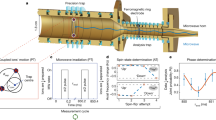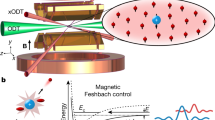Abstract
THE monoelectron oscillator1 consists of a ∼ 1-meV electron contained in a weak electric quadrupole field plus strong axial magnetic field (the Penning trap) on which the axial oscillation is continuously observable. It may profitably be looked on as an ultraheavy metastable pseudoatom, ‘geonium’ (through the trap and the magnet, the electron is bound to the Earth ultimately). The energy levels are given by2 with v c = eH/2πmc, 2v c v m − 2v m2 = v z2. We report here the measurement of the axial, magnetron, cyclotron, and spin-cyclotron-beat frequencies v z , v m , v c − v m and v s −v c +v m using this apparatus, held at 4K. A new axial-frequency-shift technique using a 30-gauss deep magnetic bottle superimposed on the 18-kgauss field supplied by a superconducting magnet was used for the last two frequencies. The road to this advance was paved by two developments, namely the anharmonicity compensated trap3 yielding an axial line width of 10−7 and the “entropy reduction by motional sideband excitation” (ref. 4) method. The latter allows the centring of an electron liberated in the trap to close tolerance guaranteeing the constancy of v z .
with v c = eH/2πmc, 2v c v m − 2v m2 = v z2. We report here the measurement of the axial, magnetron, cyclotron, and spin-cyclotron-beat frequencies v z , v m , v c − v m and v s −v c +v m using this apparatus, held at 4K. A new axial-frequency-shift technique using a 30-gauss deep magnetic bottle superimposed on the 18-kgauss field supplied by a superconducting magnet was used for the last two frequencies. The road to this advance was paved by two developments, namely the anharmonicity compensated trap3 yielding an axial line width of 10−7 and the “entropy reduction by motional sideband excitation” (ref. 4) method. The latter allows the centring of an electron liberated in the trap to close tolerance guaranteeing the constancy of v z .
This is a preview of subscription content, access via your institution
Access options
Subscribe to this journal
Receive 51 print issues and online access
$199.00 per year
only $3.90 per issue
Buy this article
- Purchase on Springer Link
- Instant access to full article PDF
Prices may be subject to local taxes which are calculated during checkout
Similar content being viewed by others
References
Wineland, D., Ekstrom, P., and Dehmelt, H., Phys. Rev. Lett., 31, 1279 (1973).
Sokolov, A. A., and Pavlenko, Yu. G., Opt. Spectrosc., 22, 1 (1967).
Van Dyck, R., Jr, Wineland, D., Ekstrom, P., and Dehmelt, H., Appl. Phys. Lett., 28, 446 (1976).
Dehmelt, H., Nature, 262, 777–778 (1976).
Dehmelt, H., and Ekstrom, P., Bull. Am. phys. Soc., 18, 727 (1973).
Dehmelt, H., Ekstrom, P., Wineland, D., and Van Dyck, R., Jr, Bull. Am. phys. Soc., 19, 572 (1974).
Dehmelt, H., Adv. atom. molec. Phys., 3, 53–72 (1967); ibid., 5, 109–154 (1969).
Barbieri, R., and Remiddi, E., in Atomic Masses and Fundamental Constants, 5, 520 (Plenum, New York and London, 1976).
Primack, J. R., in Proc. XVIth Int. Conf. High Energy Physics (Chicago, 1972).
Author information
Authors and Affiliations
Rights and permissions
About this article
Cite this article
Van Dyck, R., Ekstrom, P. & Dehmelt, H. Axial, magnetron, cyclotron and spin-cyclotron-beat frequencies measured on single electron almost at rest in free space (geonium). Nature 262, 776–777 (1976). https://doi.org/10.1038/262776a0
Received:
Accepted:
Published:
Issue Date:
DOI: https://doi.org/10.1038/262776a0
This article is cited by
-
The electron is cool
Nature (2003)
-
New continuous Stern-Gerlach effect and a hint of ?the? elementary particle
Zeitschrift f�r Physik D Atoms, Molecules and Clusters (1988)
-
Quantum jump
Nature (1987)
Comments
By submitting a comment you agree to abide by our Terms and Community Guidelines. If you find something abusive or that does not comply with our terms or guidelines please flag it as inappropriate.



